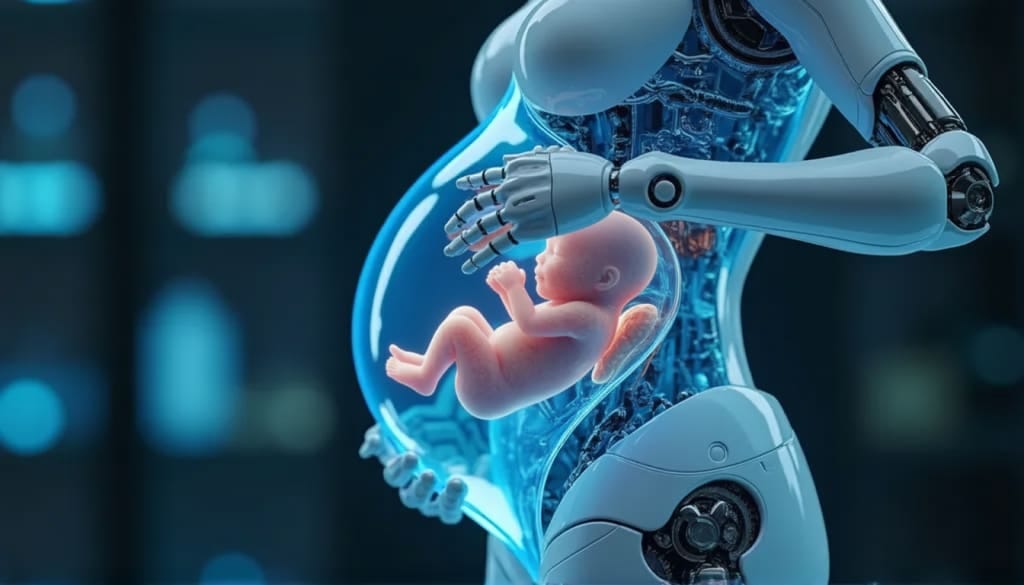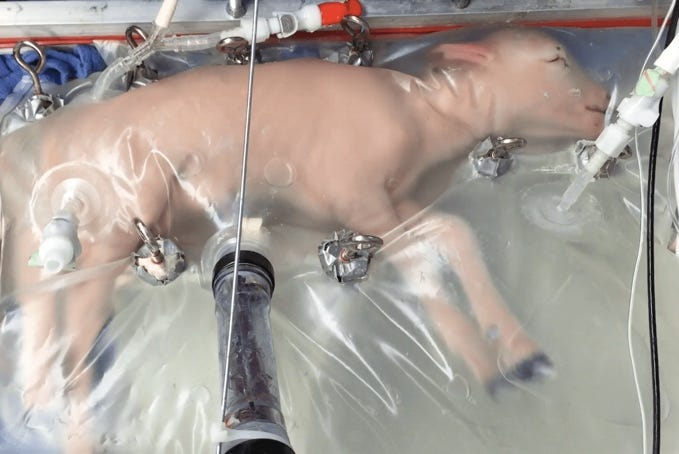Will Chinese Pregnancy Robots Replace All of Us—Here at the CHR—Next Year?

We are sure you in recent days heard about Chinese pregnancy robots scheduled to come to market next year already, which not only mimic the appearance of pregnant women, but can achieve fertilization of eggs through spermatozoa, thus produce good quality embryos, which then can implant in an artificial uterus, and normally grow over ca. 9 months into a 40 week pregnancy of fetus and placenta, only to be delivered by the robot. And if you believe that—as a surprising number of even otherwise quite responsible media did—then we know of a beautiful bridge we want to sell you for very cheap.
We don’t think so, but this is what, apparently, a Chinese company claimed to be “on the verge of accomplishing.”1 And the media, of course, fell for it!
The company, Kaiwa Technology, in the city of Guangzhou, just a one-hour train ride from Hong Kong, recently announced at the August World Robot Conference in Beijing that the company was in the process of developing the world’s first “humanoid pregnancy robot.”
And not only did the company promise a prototype in 2026, but it also announced that it will have the robot already commercially available by next year.
Aware of how disappointingly slow companies all around the world have been making progress in attempts to automate the embryo laboratory alone, the company’s announcement of producing a complete humanoid robot that, in addition to producing the embryo, also can nurture it to maturity for nine months, still sounds much more like science fiction than a credible reality.
But to make the whole story even less credible, the company claims that the humanoid robot will be offered a the ridiculously low price of approximately (U.S.) $13,900. Even a single incubator bank for an embryology laboratory is more expensive than that, yet this project claims to combine “advanced artificial womb technology” (whatever that means) with a robotic form (see the figure above for a possibly slightly off interpretation of what such a robot could look like).
And it is not only that embryology automatization is still in relatively early stages; growing a human embryo for longer than a few days beyond the blastocyst stage has, for obvious ethical reasons alone, never been tried. And even in a sheep model, the goal of in vitro extrauterine maturations of pregnancies has remained a dream. Indeed, since 2017, when a group of investigators from The Children’s Hospital of Philadelphia Research Institute (corresponding author, Alan W. Flake, MD) reported an extrauterine system to physiologically support extremely premature lambs for a few weeks,2 no other study has followed.

We suspect that the hoopla surrounding this announcement was the marketing strategy of a start-up company looking for investors. But we, of course, would be pleasantly surprised by being wrong. The CHR in 2026 will—definitely—be standing in line to purchase one of the first available pregnancy robots from the company, even if the price is a few thousand U.S. dollars higher than announced (though, of course, within limits!). Kaiwa Technology in the city of Guangzhou, are you listening?!
Somewhat surprisingly, even the New York Post fell for this likely marketing scam, describing the announcement as a “revolutionary breakthrough” and “game changer for infertile couples.” Fabiana Buontempo, call us the next time at the CHR for a fact-check before falling into a marketing trap and writing an article in The Post, which then leads to the flooding of telephone lines and our message center with questions from curious patients. We fact-check all the time—and with pleasure—for many of your colleagues, and you don’t even have to mention us, though we, of course, do appreciate it if you do!
References
Zamora F. Robots Will Be Able to Give Birth. Futurism. Published August 19, 2025. https://vocal.media/futurism/robots-will-be-able-to-give-birth
Partridge L, Deelen J, Slagboom PE. Facing up to the global challenges of aging. Nat Commun. 2017;8:15112. doi:10.1038/ncomms15112

